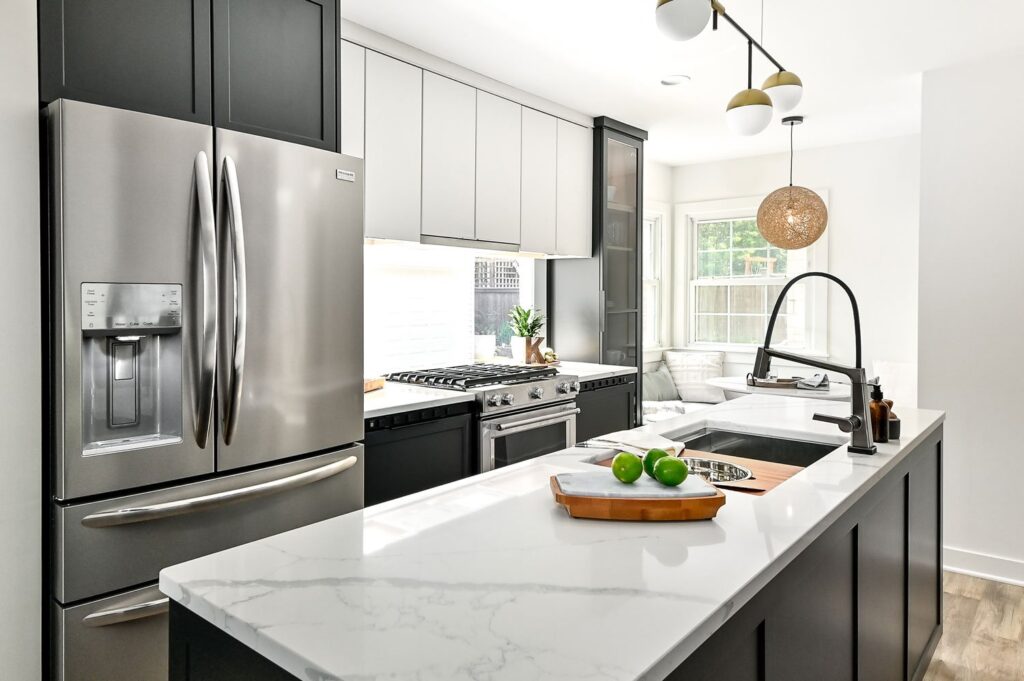
Embarking on a kitchen remodel is an exciting endeavor that breathes new life into one of the most essential spaces in our homes. However, amidst the anticipation of a beautiful and functional kitchen, a question often lingers: how long does a kitchen remodel take? While it may be tempting to assume that a simple answer exists, the reality is that the duration of a kitchen remodel depends on several factors. From meticulous planning and design to the intricate process of installation and finishing touches, each phase contributes to the overall timeline. Let’s explore the various stages of a kitchen remodel and uncover the answer to this elusive question.
Planning and Design Phase
During a kitchen remodel’s Planning and Design Phase, meticulous attention to detail and careful consideration of the homeowner’s needs and preferences are paramount to creating a functional and aesthetically pleasing space. This phase is where the groundwork for the entire project is laid, and it involves numerous budgeting considerations and hiring professionals.
One of the first tasks in this phase is establishing a remodel budget. This requires careful consideration of the homeowner’s financial resources and priorities. Decisions will need to be made about how much to allocate for materials, appliances, labor costs, and any additional expenses that may arise during the project.
Hiring professionals is another crucial aspect of the Planning and Design Phase. Finding experienced contractors, architects, and designers who can bring the homeowner’s vision to life is essential. These professionals will work closely with the homeowner to develop a detailed plan, create realistic timelines, and ensure the project stays within budget.
Demolition and Preparation
The kitchen remodel project’s initial phase involves the meticulous demolition and preparation process, where careful attention to detail and experienced techniques are employed to ensure a smooth transition to the following stages of construction. During this stage, the existing kitchen is stripped to its bare bones, with cabinets, countertops, appliances, and fixtures removed. Walls may need to be knocked down or adjusted to accommodate the new design. Flooring and subflooring may also be removed or replaced. This phase is crucial as it sets the foundation for the rest of the project. It is important to note that the duration of the demolition and preparation phase can vary depending on the complexity of the remodel and any unforeseen obstacles that may arise. Additionally, cost considerations should be taken into account, as demolition and preparation expenses can vary depending on the scope of the project and any unforeseen issues that may arise during this stage.
Installation of Cabinets and Countertops
Installing cabinets and countertops requires meticulous precision and expert craftsmanship to transform your kitchen successfully. The cabinet styles you choose will set the tone for the entire space, whether you opt for sleek and modern or traditional and elegant. As the cabinets are installed, envision the transformation before your eyes, with each door and drawer carefully aligned and secured. The countertop materials you select will enhance the aesthetic appeal and provide durability and functionality. Picture the smooth, polished surface of granite or the sleek elegance of quartz, perfectly cut and fitted to your specifications. Installing cabinets and countertops is a critical step in creating a kitchen that reflects your style and meets your practical needs.
Plumbing and Electrical Work
Executing precise plumbing and electrical work is crucial for successfully completing your kitchen remodel, ensuring that your new space is aesthetically pleasing but also functional and safe. When it comes to upgrading fixtures, it is essential to consider your kitchen’s overall design and functionality. This includes selecting suitable faucets, sinks, and other plumbing fixtures that complement your style while providing the necessary features for your daily tasks. Additionally, rewiring appliances is an essential part of the process. This involves ensuring that your kitchen’s electrical system can handle your new appliances’ power requirements and properly connecting and grounding them to avoid any safety hazards. By paying attention to these details and working with experienced professionals, you can ensure that your kitchen remodel incorporates the necessary plumbing and electrical work to create a beautiful and functional space.
Finishing Touches and Clean-Up
With the plumbing and electrical work successfully completed, it is time to focus on adding the finishing touches and completing the clean-up process for your kitchen remodel. In this stage, you can truly bring your vision to life and turn your kitchen into a space that reflects your style and taste. Here are a few tasks to consider during this phase:
– Decorative accents: Install the backsplash tiles that will complement your countertops and cabinetry, adding a pop of color and texture. Hang up artwork or add shelving for displaying your favorite kitchenware or decorative items.
– Post-remodel organization: Take this opportunity to reorganize your kitchen and create a more functional layout. Install additional storage solutions such as pull-out drawers or custom pantry shelves to maximize space and keep everything organized and easily accessible.
As you add these final touches, ensure you complete the clean-up process, removing any construction debris and thoroughly cleaning your kitchen. This will ensure that your kitchen remodel is complete and ready for you to enjoy.


